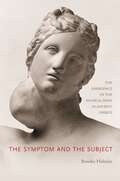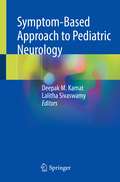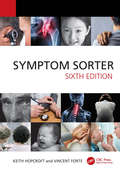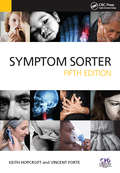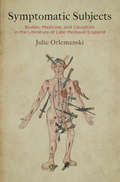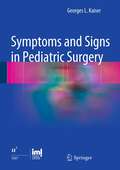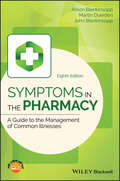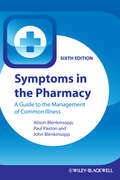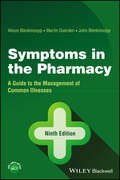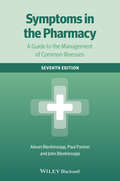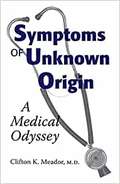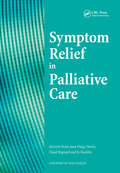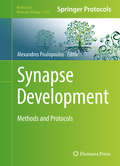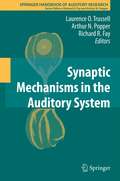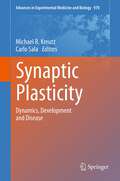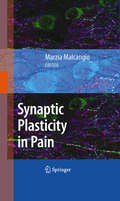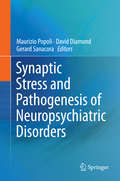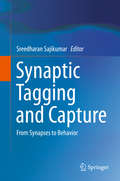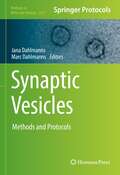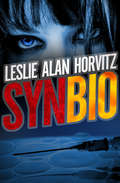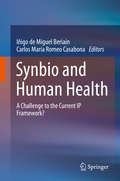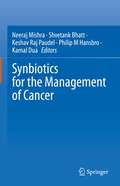- Table View
- List View
The Symptom and the Subject: The Emergence of the Physical Body in Ancient Greece
by Brooke HolmesThe Symptom and the Subject takes an in-depth look at how the physical body first emerged in the West as both an object of knowledge and a mysterious part of the self. Beginning with Homer, moving through classical-era medical treatises, and closing with studies of early ethical philosophy and Euripidean tragedy, this book rewrites the traditional story of the rise of body-soul dualism in ancient Greece. Brooke Holmes demonstrates that as the body (sôma) became a subject of physical inquiry, it decisively changed ancient Greek ideas about the meaning of suffering, the soul, and human nature. By undertaking a new examination of biological and medical evidence from the sixth through fourth centuries BCE, Holmes argues that it was in large part through changing interpretations of symptoms that people began to perceive the physical body with the senses and the mind. Once attributed primarily to social agents like gods and daemons, symptoms began to be explained by physicians in terms of the physical substances hidden inside the person. Imagining a daemonic space inside the person but largely below the threshold of feeling, these physicians helped to radically transform what it meant for human beings to be vulnerable, and ushered in a new ethics centered on the responsibility of taking care of the self. The Symptom and the Subject highlights with fresh importance how classical Greek discoveries made possible new and deeply influential ways of thinking about the human subject.
Symptom-Based Approach to Pediatric Neurology
by Deepak M. Kamat Lalitha SivaswamyPrimary health care providers such as pediatricians and family medicine physicians commonly encounter children with neurologic symptoms such as headache, double vision, facial weakness etc. Most books currently available in the specialty of pediatric neurology are “condition” or “disorder” based, and most of them are geared towards pediatric neurologists, not generalists who take care of children. A common thread amongst most currently available books in Pediatric Neurology is that the practitioner already knows what “condition” or “disorder” the child is suffering from. This book focuses on symptoms to a large extent. However, children with chronic neurological conditions will follow up with their primary care physicians after their visit with the sub-specialists. They may have questions or ongoing concerns regarding the diagnosis that has been made or being considered. This book attempts to provide information to the primary care physician regarding management and follow up of such children as well. This book serves as a guide for busy clinicians who take care of children presenting with neurological symptoms- with special emphasis on symptoms that are commonly encountered in clinical practice. For each symptom, a brief introduction is given as well as a definition and epidemiologic information for the given symptom. Readers are also instructed on what historical features and physical examinations are essential in narrowing the differential diagnosis. A recommendation on the management of the condition is then established. Instructions on when one should refer the patient to subspecialists for further evaluation and management are clearly laid out. Finally, a list of appropriate resources is provided for families, as well as clinical pearls that can be quickly scanned when one is pressed for time. The overarching goal of this book is to enable the primary care physician to make a confident diagnosis, triage efficiently and initiate treatment if need be. Written by experts in the field, Symptom-Based Approach to Pediatric Neurology is a valuable resource for evaluation and management of children presenting with neurologic symptoms for primary care providers who take care of children.
Symptom Sorter
by Keith Hopcroft Vincent Forte&‘…approaches the consultation intuitively … The book oozes with patience for the patient and for the reader. What better prescription for the clinic could the practitioner need?&’ Glycosmedia (of the Fifth Edition) &‘… this is a book worth having available at the point of care for health professionals, including doctors, nurses, undergraduates and postgraduates, to help them make sense of common symptoms. With the help of the authors&’ opinions in combination with our own experience we should then be able to make better clinical decisions.&’ Sultan Qaboos University Medical Journal (of the Fourth Edition) Across its six editions, Symptom Sorter has excelled in redressing the balance between symptoms and diagnoses to become the essential handbook to accompany the consultation in primary care. Presenting a multitude of symptoms commonly encountered in primary care, these are meticulously explored using the red flags, top tips and ready reckoner format for sorting symptoms that have made previous editions so popular and respected. This revised and updated sixth edition includes several new chapters and features expanded coverage of paediatric symptoms. Key features: · Fully updated, with &‘investigations&’ sections amended in line with latest guidelines and significant revisions throughout · Brand new chapters on acute abdominal pain in childhood, hand and wrist swellings, diarrhoea in children, loin pain, rectal bleeding in children, vomiting in babies, skinfold rash and dysuria · Consistent and logical presentation enables speedy access · Replicates accurately the experience in the consultation or clinic An invaluable reference for all general practitioners, especially GP trainers and registrars, this new edition of Symptom Sorter is also highly recommended for advanced nurse practitioners, A&E nurses and pharmacists requiring a concise, easy-to-use guide. The authors: Keith Hopcroft is a GP in Basildon, Essex, UK, an associate trainer, an editorial adviser to Pulse, and a medical writer and columnist. Vincent Forte is a former GP based in Norfolk, UK
Symptom Sorter, Fifth Edition
by Keith Hopcroft Vincent ForteHighly Commended, BMA Medical Book Awards 2015Across its five editions, Symptom Sorter has excelled in redressing the balance between symptoms and diagnoses to become the essential reference book in primary care..Presenting a multitude of symptoms commonly encountered in primary care, this fully revised and greatly expanded edition features brand n
Symptomatic Subjects: Bodies, Medicine, and Causation in the Literature of Late Medieval England (Alembics: Penn Studies in Literature and Science)
by Julie OrlemanskiIn the period just prior to medicine's modernity—before the rise of Renaissance anatomy, the centralized regulation of medical practice, and the valorization of scientific empiricism—England was the scene of a remarkable upsurge in medical writing. Between the arrival of the Black Death in 1348 and the emergence of printed English books a century and a quarter later, thousands of discrete medical texts were copied, translated, and composed, largely for readers outside universities. These widely varied texts shared a model of a universe crisscrossed with physical forces and a picture of the human body as a changeable, composite thing, tuned materially to the world's vicissitudes. According to Julie Orlemanski, when writers like Geoffrey Chaucer, Robert Henryson, Thomas Hoccleve, and Margery Kempe drew on the discourse of phisik—the language of humors and complexions, leprous pustules and love sickness, regimen and pharmacopeia—they did so to chart new circuits of legibility between physiology and personhood.Orlemanski explores the texts of her vernacular writers to show how they deployed the rich terminology of embodiment and its ailments to portray symptomatic figures who struggled to control both their bodies and the interpretations that gave their bodies meaning. As medical paradigms mingled with penitential, miraculous, and socially symbolic systems, these texts demanded that a growing number of readers negotiate the conflicting claims of material causation, intentional action, and divine power. Examining both the medical writings of late medieval England and the narrative and poetic works that responded to them, Symptomatic Subjects illuminates the period's conflicts over who had the authority to construe bodily signs and what embodiment could be made to mean.
Symptome als Wegweiser: Woher kommen Kopfweh, Schwindel, Zuckungen?
by Martina Kahl-ScholzWer kennt das nicht: Die Hand zittert, der Magen grummelt, der Kopf schmerzt oder die Muskeln zucken, ohne dass man sie dazu aufgefordert hat. Und wirklich verstehen, warum uns unser Körper diese Symptome sendet, geschweige denn erklären, woher sie kommen, können wir häufig nicht. Und während wir uns blind jedem Navigationssystem anvertrauen (und nicht selten irregeführt werden), stehen wir diesen Signalen unseres eigenen Körpers häufig misstrauisch oder ängstlich gegenüber – und ignorieren sie nicht selten einfach weg. Warum ist es aber so wichtig, auf den Körper zu hören und ihm zu vertrauen? Was teilt er uns mit? Welche Fährte legt er, der wir folgen sollten? Um solche und viele weitere Fragen geht es in diesem Buch und darum, sich selbst besser wahrnehmen und verstehen zu können – denn über das Verständnis, was ein Symptom bedeutet, woher es kommt und wohin es weist, werden wir zum besseren Coach unserer Gesundheit. In einer leicht verständlichen Sprache und manchmal mit einem Augenzwinkern wird über gängige Beschwerden aufgeklärt, wie sie jeder schon einmal an sich selbst erfahren hat: Wie entsteht Schwindel und was bedeutet er? Was verursacht den Pfeifton im Ohr und kann man etwas dagegen tun? Warum verspannen sich Muskeln und wie kann dem vorgebeugt werden? Jedes Kapitel umfasst diese drei Fragen: Warum entsteht ein Symptom?In welchen Varianten kann es sich zeigen?Wo weist es hin? Dieses Buch soll dem Interessierten helfen, den Wegweisern des eigenen Körpers auf den Grund zu gehen und dem Navigationssystem Körper besser folgen zu können.
Symptoms and Signs in Pediatric Surgery
by Georges L. KaiserThis concise textbook of pediatric surgery is designed to guide the reader logically from symptoms and signs to diagnosis and treatment. Each chapter is devoted to one of 35 key symptoms and signs, which are organized according to six body regions: head, neck, chest, abdomen, urogenital system, and back. In each case, a brief assessment of the presenting sign/symptom and differential diagnosis is followed by discussion of occurrence, clinical presentation and significance, diagnostic work-up, treatment, and prognosis. Informative tables, illustrations, and up-to-date references are included throughout. Readers will also have access to an e-learning tool developed in collaboration with the Institute of Medical Education, University of Bern, which highlights the characteristics of pediatric surgical disorders and their treatment and includes clinical, radiological, and intraoperative images.
Symptoms in the Pharmacy: A Guide to the Management of Common Illnesses
by Alison Blenkinsopp Martin Duerden John BlenkinsoppInformed by the experiences and expertise of seasoned pharmacists and GPs, this reference guide provides pharmacists working in the community with the treatment information they need when they need it. Each chapter incorporates a decision-making framework which distills the information necessary for treatment along with suggestions on “when to refer” set off in summary boxes. Throughout elucidating case studies are provided in which pharmacists and doctors describe, in their own words, listening to and treating patients suffering with a range of common problems, from migraine to eczema to IBS. The indispensable guide to assessing and managing common symptoms seen in the pharmacy Includes information about medicines recently reclassified for OTC supply such as those for malaria prophylaxis and psoriasis Now includes more highlights of “Red Flag” signs and symptoms Covers respiratory, gastrointestinal, skin, ear and eye, cardiovascular, and pain conditions Offers specific recommendations for women’s, men’s and children’s health problems Provides decision making support for cases involving ethical dilemmas Features a visual display of guidelines Emphasizes the evidence base for OTC medicines With expert coverage of most common ailments which will be encountered by pharmacists on a daily basis, Symptoms in the Pharmacy, 8th Edition is a professional resource you’ll want to keep close at hand for frequent consultation.
Symptoms in the Pharmacy: A Guide to the Management of Common Illness
by Alison Blenkinsopp Paul Paxton John BlenkinsoppA practical and evidence-based guide for student, pre-registration and qualified pharmacists Symptoms in the Pharmacy is an indispensable guide to the management of common symptoms seen in the pharmacy. With advice from an author team that includes both pharmacists and GPs, the book covers ailments which will be encountered in the pharmacy on a daily basis. Now in its sixth edition Symptoms in the Pharmacy has been fully revised to reflect the latest evidence and availability of new medicines. There are new sections and case studies for 'POM' to 'P' switches including chloramphenicol, sumatriptan, diclofenac, naproxen and amorolfine. This edition features colour photographs of skin conditions for the first time enabling the differentiation and diagnosis of common complaints. The public health and illness prevention content have been expanded to support this increasingly important aspect of the pharmacist’s work. The book is designed for quick and easy reference with separate chapters for each ailment. Each chapter incorporates a decision making framework in which the information necessary for treatment and suggestions on ‘when to refer’ is distilled into helpful summary boxes. At the end of each chapter there are example case studies providing the view of pharmacists, doctors and patients for most conditions covered. These easy-to-follow- chapters can be read cover to cover or turned to for quick reference. This useful guide should be kept close at hand for frequent consultation.
Symptoms in the Pharmacy: A Guide to the Management of Common Illnesses
by Martin Duerden Alison Blenkinsopp John BlenkinsoppA Thorough Guidebook for Assessing and Managing Common Symptoms and Illnesses Seen in the Pharmacy Pharmacies, and pharmacists, are often the first source for information and advice used by a patient when health problems arise. This book supports pharmacists to recognize symptoms, advise with confidence, and recommend appropriate treatment or referral, while also providing a comprehensive digest of common conditions ideal for both practical use and reference. Informed by the experiences and expertise of seasoned pharmacists and GPs, each chapter in the book provides pharmacists and their staff working in the community with a decision-making framework along with suggestions on &“when to refer&” contained within summary boxes. A unique feature of the book is that case studies are provided throughout, in which pharmacists, doctors, nurses and patients themselves describe assessment and treatment of a wide range of common problems. This 9th edition of the book also includes: Consideration of conducting pharmacy consultations remotely as well as in person in the pharmacy New content on COVID-19 and Long-COVID in pharmacy practice Information about medicines recently reclassified for OTC supply Expanded content on women&’s health including information on desogestrel, menopause and incontinence Broadening of the insomnia chapter to include consideration of mental health problems Increased content on non-drug treatment options and their supporting evidence A summary of evidence sources at the end of each chapter Decision-making support for unique cases which involve ethical dilemmasPracticing and Foundation trainee pharmacists, as well as undergraduate pharmacy students and other healthcare professionals, will find Symptoms in the Pharmacy: A Guide to the Management of Common Illnesses invaluable when dealing with both common and obscure symptoms and illnesses.
Symptoms in the Pharmacy
by Paul Paxton Alison Blenkinsopp John BlenkinsoppA practical and evidence-based guide for student, pre-registration and qualified pharmacistsSymptoms in the Pharmacy is an indispensable guide to the management of common symptoms seen in the pharmacy. With advice from an author team that includes both pharmacists and GPs, the book covers ailments which will be encountered in the pharmacy on a daily basis. Now in its sixth edition Symptoms in the Pharmacy has been fully revised to reflect the latest evidence and availability of new medicines. There are new sections and case studies for 'POM' to 'P' switches including chloramphenicol, sumatriptan, diclofenac, naproxen and amorolfine. This edition features colour photographs of skin conditions for the first time enabling the differentiation and diagnosis of common complaints. The public health and illness prevention content have been expanded to support this increasingly important aspect of the pharmacist's work.The book is designed for quick and easy reference with separate chapters for each ailment. Each chapter incorporates a decision making framework in which the information necessary for treatment and suggestions on 'when to refer' is distilled into helpful summary boxes. At the end of each chapter there are example case studies providing the view of pharmacists, doctors and patients for most conditions covered. These easy-to-follow- chapters can be read cover to cover or turned to for quick reference. This useful guide should be kept close at hand for frequent consultation.
Symptoms of Unknown Origin: A Medical Odyssey
by Clifton K. M.D.For years after graduating from medical school, Dr. Clifton K. Meador assumed that symptoms of the body, when obviously not imaginary, indicate a disease of the body--something to be treated with drugs, surgery, or other traditional means. But, over several decades, as he saw patients with clear symptoms but no discernable disease, he concluded that his own assumptions were too narrow and, indeed, that the underlying basis for much of clinical medicine was severely limited. Recounting a series of fascinating case studies, Meador shows in this book how he came to reject a strict adherence to the prevailing biomolecular model of disease and its separation of mind and body. He studied other theories and approaches--George Engel's biopsychosocial model of disease, Michael Balint's study of physicians as pharmacological agents--and adjusted his practice accordingly to treat what he called "nondisease." He had to retool, learn new and more in-depth interviewing and listening techniques, and undergo what Balint termed a "slight but significant change in personality." In chapters like "The Woman Who Believed She Was a Man" and "The Diarrhea of Agnes," Meador reveals both the considerable harm that can result from wrong diagnoses of nonexistent diseases and the methods he developed to help patients with chronic symptoms not defined by a medical disease. Throughout the book, he recommends subsequent studies to test his observations, and he urges full application of the scientific method to the doctor-patient relationship, pointing out that few objective studies of these all-important interactions have ever been done.
Symptoms of Unknown Origin: A Medical Odyssey
by Clifton K. MeadorFor years after graduating from medical school, Dr. Clifton K. Meador assumed that symptoms of the body, when obviously not imaginary, indicate a disease of the body—something to be treated with drugs, surgery, or other traditional means. But, over several decades, as he saw patients with clear symptoms but no discernable disease, he concluded that his own assumptions were too narrow and, indeed, that the underlying basis for much of clinical medicine was severely limited.Recounting a series of fascinating case studies, Meador shows in this book how he came to reject a strict adherence to the prevailing biomolecular model of disease and its separation of mind and body. He studied other theories and approaches—George Engel's biopsychosocial model of disease, Michael Balint's study of physicians as pharmacological agents—and adjusted his practice accordingly to treat what he called "nondisease." He had to retool, learn new and more in-depth interviewing and listening techniques, and undergo what Balint termed a "slight but significant change in personality."In chapters like "The Woman Who Believed She Was a Man" and "The Diarrhea of Agnes," Meador reveals both the considerable harm that can result from wrong diagnoses of nonexistent diseases and the methods he developed to help patients with chronic symptoms not defined by a medical disease. Throughout the book, he recommends subsequent studies to test his observations, and he urges full application of the scientific method to the doctor-patient relationship, pointing out that few objective studies of these all-important interactions have ever been done.
Sympton Relief in Palliative Care (Radcliffe Ser.)
by Michael LeviThis is an updated guide to the range of drugs commonly unused in the treatment of psychiatric disorders. There have been many significant changes in drug treatment over the last few years, and "Basic Notes in Psychopharmacology" provides an overview of both new and old drugs, their mode of action, indications and adverse effects. The four sections of the book deal with hypnotic and anxiolytic drugs, antipsychotic drugs, antidepressant drugs and mood stabilizers. The book should be a useful guide for all those involved in the use of drugs in psychiatry. In particular, junior doctors, general practitioners and medical students should find it valuable as an introduction to this complex and rapidly changing area as well as a useful revision aid for examinations. However, psychiatric nurses, psychiatric social workers and psychiatric occupational therapists and clinical psychologists should also find the book an asset.
Synapse Development
by Alexandros PoulopoulosThis detailed volume collects protocols for experimentation into how neurons connect to produce the extraordinary functionalities of the nervous system. Contributed by experts and pioneers in their respective techniques, the book covers synapses in the brain and in culture, their constituents, their structures, their dynamics, and the assemblies they form, all in the structure of a laboratory guide. Written for the highly successful Methods in Molecular Biology series, chapters include brief introductions to their respective topics, lists of the necessary materials and reagents, step-by-step, readily reproducible laboratory protocols, and tips on troubleshooting and avoiding known pitfalls. Authoritative and practical, Synapse Development: Methods and Protocols serves as an ideal guide to minimizing the barrier to entry for the integration of new approaches with existing expertise, producing syntheses that will foster novel perspectives on the many ways in which synapses form, transform, and transmit.
Synaptic Mechanisms in the Auditory System
by Laurence O. Trussell Richard R. Fay Arthur N. PopperSynaptic Mechanisms in the Auditory System will provide a basic reference for students, clinicians, and researchers on how synapses in the auditory system function to encode acoustic signals. These mechanisms are the groundwork for all auditory processing, and understanding them requires knowledge of the microphysiology of synapses, cellular biophysics, receptor pharmacology, and an appreciation for what these synapses must do for a living, what unique jobs they carry out.
Synaptic Plasticity
by Michael R. Kreutz Carlo SalaThis book introduces the current concepts of molecular mechanisms in synaptic plasticity and provides a comprehensive overview of cutting-edge research technology used to investigate the molecular dynamics of the synapses. It explores current concepts on activity-dependent remodeling of the synaptic cytoskeleton and presents the latest ideas on the different forms of plasticity in synapses and dendrites. Synaptic Plasticity in Health and Disease not only supplies readers with extensive knowledge on the latest developments in research, but also with important information on clinical and applied aspects. Changes in spine synapses in different brain disease states, so-called synaptopathies, are explained and described by experts in the field. By outlining basic research findings as well as physiological and pathophysiological impacts on synaptic plasticity, the book represents an essential state-of-the-art work for scientists in the fields of biochemistry, molecular biology and the neurosciences, as well as for doctors in neurology and psychiatry alike.
Synaptic Plasticity in Pain
by Marzia MalcangioPrimary sensory neurons respond to peripheral stimulation and project to the spinal cord. Specifically, the population of neurons which respond to damaging stimuli terminate in the superficial layers of the dorsal horn. Therefore, the dorsal horns constitute the first relay site for nociceptive fibre terminals which make synaptic contacts with second order neurons. It has recently become clear that the strength of this first pain synapse is plastic and modifiable by several modulators, including neuronal and non-neuronal regulators, and studies on the fundamental processes regulating the plasticity of the first pain synapse have resulted in the identification of new targets for the treatment of chronic pain. This book will be of interest to a wide readership in the pain field.
Synaptic Self: How Our Brains Become Who We Are
by Joseph LedouxIn 1996 Joseph LeDoux's The Emotional Brain presented a revelatory examination of the biological bases of our emotions and memories. Now, the world-renowned expert on the brain has produced with a groundbreaking work that tells a more profound story: how the little spaces between the neurons—the brain's synapses—are the channels through which we think, act, imagine, feel, and remember. Synapses encode the essence of personality, enabling each of us to function as a distinctive, integrated individual from moment to moment. Exploring the functioning of memory, the synaptic basis of mental illness and drug addiction, and the mechanism of self-awareness, Synaptic Self is a provocative and mind-expanding work that is destined to become a classic. .
Synaptic Stress and Pathogenesis of Neuropsychiatric Disorders
by Maurizio Popoli David Diamond Gerard SanacoraRecent studies show that changes in Glutamate/GABA synapses and related pathways may determine whether the synaptic plasticity that occurs as a response to stress is adaptive or maladaptive. Findings have shed new light on the mechanisms that determine the effects of stress on cognitive and affective function. Researchers have brought a wide range of techniques to bear on the study of this problem, including cutting-edge live imaging techniques, electrophysiology, glutamate release from isolated live synaptic terminals, development of transgenic and animal models and new behavioral methods. This book provides an overview of these recent findings and of the techniques used as well as a discussion of how the molecular, cellular, and functional effects of stress may trigger or precipitate neuropsychiatric disorders such as depression, schizophrenia, anxiety and PTSD.
Synaptic Tagging and Capture
by Sreedharan SajikumarServes as a comprehensive introduction and overview of synaptic tagging and capture (STC) and covers the topic from molecular and cellular aspects to behavior. Circa 15 years ago the STC model was proposed to provide a conceptual basis for how short-term memories are transformed into long-term memories. Though the hypothesis remains unconfirmed due to technological limitations, the model is well consolidated and generally accepted in the field. Various researchers have investigated the cellular mechanisms for the formation of long-term memory using the STC model, but this is the first book-length treatments of STC. This volume features an introduction by Prof. Richard Morris and Prof. Cliff Abraham.
Synaptic Vesicles: Methods and Protocols (Methods in Molecular Biology #2417)
by Jana Dahlmanns Marc DahlmannsThis book provides protocols on the preparation of synaptic vesicles from different model systems and provides instructions for functional investigations of their transport and formation, scaffolding, filling and priming, release, recycling, and degradation. Chapters guide readers through computational approaches, simulating different aspects of synaptic vesicle anatomy and function. Written in the format of the highly successful Methods in Molecular Biology series, each chapter includes an introduction to the topic, lists necessary materials and reagents, includes tips on troubleshooting and known pitfalls, and step-by-step, readily reproducible protocols. Authoritative and cutting-edge, Synaptic Vesicles: Methods and Protocols aims to be a useful practical guide to researchers to help further their study in this field.
SynBio
by Leslie A HorvitzScientists now have the capacity to hack into DNA the same way that hackers can infiltrate computer systems, manipulating organisms by inserting new DNA or exploiting genetic mutations that can trigger fatal heart attacks or induce bipolar illness or Alzheimer’s. These “biohackers,” as they’re known, can perform their experiments in their kitchens using equipment purchased for next to nothing on eBay.Most of these biohackers are like Seth Stringer in Cambridge, Massachusetts, who’s made a name for himself exploring the frontiers of genetic manipulation. He’s young, brash, ambitious, and obsessed with his work, but also a little naive. When his former professor Marcus Adair holds out the possibility of coming to London and going to work for an international pharmaceutical company called Chimera, he jumps at the chance. He can make good money and cement his relationship with his girlfriend, who has misgivings about his future prospects as a breadwinner. He fails to realize until too late that the principal business of Chimera isn’t the manufacture of generic drugs but the production of lethal genetic products for well-heeled clients. These are used to assassinate or debilitate presidents, prime ministers, and CEOs using their own DNA against them—a method that not only makes it difficult to identify the perpetrator (a cold virus can deliver the engineered DNA) but makes it almost impossible to determine that a crime has been committed in the first place.
Synbio and Human Health
by Iñigo Miguel Beriain Carlos María Romeo CasabonaSince 2010, the Inter-university chair in law and the Human Genome has been involved in an EU 7th Framework Programme funded Project called Sybhel, leading work package 5. The aim of this work package was to face the issues related to synthetic biology and intellectual property rights. In these years, the Chair organized two international workshops devoted to this topic, collecting a number of high level unpublished papers redacted by some of the most prominent experts in this field worldwide, including Stephen Maurer, Joachim Henkel, Ingrid Schneider, etc. We consider that it would be extremely interesting to have them all gathered in a unique contributed volume, which would be the first book exclusively dedicated to analyze the implications that Synbio may involve in what refers to the currently existing intellectual property rights system.
Synbiotics for the Management of Cancer
by Neeraj Mishra Shvetank Bhatt Keshav Raj Paudel Philip M Hansbro Kamal DuaThis book illustrates the significance of probiotics and prebiotics for the management of various types of cancers. The up-to-date chapters provide recent information about the effect of anticancer treatment approaches on gut microbiota, the correlation between ROS and synbiotics for effective cancer treatment, and the influence of synbiotics on inflammation and immune microenvironment for cancer treatment. It also describes the regulatory issues about synbiotics in the management of cancer. This book is an essential resource for scientists working in the field of cancer, pharmaceutical & clinical sciences, and cancer clinicians. This book is also very useful for undergraduate and postgraduate students of Pharmacy and Biotechnology and medical researchers, mainly working in microbiology, immunology, and cancer biology.
